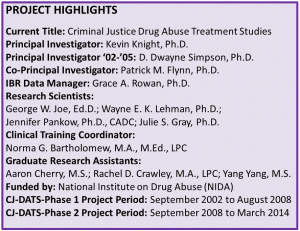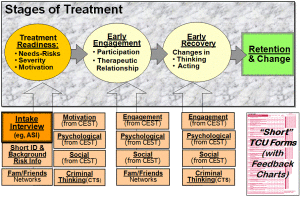
In 2002, the National Institute on Drug Abuse (NIDA) funded the Criminal Justice Drug Abuse Treatment Studies (CJ-DATS I) cooperative agreement. The Institute of Behavioral Research at Texas Christian University (TCU) was one of nine National Research Centers selected to study current drug treatment practices and outcomes in correctional settings and to examine strategies for improving treatment services for drug-involved offenders. The primary mission of the project initially is to investigate key elements of corrections-based treatment systems in the U.S. and make recommendations for policies to enhance outcomes and improve the overall efficiency of treatment service delivery. A key objective of this landmark project is the establishment of interventions and assessments designed to assist corrections-based treatment in an effort to reduce offender drug use and crime-related costs to society.
CJ-DATS II began in 2008 and engages a different mix of nine research centers and agency partners. Studies focus on organizational and system-level implementation strategies, and engage both community corrections and community-based treatment providers in a process that involves key facilitators and barriers within the context of public safety and public health goals. Ultimately, CJ-DATS II is designed to identify implementation strategies that maximize the likelihood of sustained delivery of evidence-based practices to improve offender drug abuse and HIV outcomes, and to decrease their risk of incarceration.
Implementing research-based treatment practices in typical CJ settings faces a variety of clinical, administrative, organizational, and policy barriers. Furthermore, if the implementation solutions are expedient rather than systemic, the innovation may not be sustainable, regardless of its clinical effectiveness or cost-effectiveness. An essential component of CJ-DATS II is a focus on implementation research involving organizational change, focused on quality improvement, implementation and technology transfer, management science, and inter-organizational relationships or cross-agency collaboration.
The CJ-DATS Research Center at TCU has worked for several years with its collaborators to address a variety of concerns. Most express a need for linking offender/client assessments dynamically to targeted treatment strategies in a manner that allows progress to be monitored, documented empirically, and clients clinically managed over time. This represents a complex formulation of clinical tools (i.e., assessments and interventions), integrated applications based on user-friendly feedback of client needs and progress, and a supportive program structure. Regardless of program size or focus, experiences so far suggest this requires (1) staff preparation and leadership support, (2) structural alignments and role assignments, (3) training with customized adjustments to settings, and (4) follow-up monitoring and feedback on implementation progress. The heuristic value of the TCU Treatment Process and Outcome Model and the TCU Program Change Model is helping to provide treatment and reentry systems an understanding of the complicated treatment process, of how innovations become adopted and implemented, along with the factors that influence how well it is done and sustained.
Summary of Activities in the CJ-DATS Project

CJ-DATS began in 2002 and included nine Research Centers across the U.S. as well as NIDA scientists. The CJ-DATS Research Center at TCU had the lead role in carrying out two studies. First, as part of the Performance Indicators for Corrections (PIC) study, a series of offender assessments for needs, performance, and reentry planning was designed and tested (see Simpson & Knight, 2007; special issue for Criminal Justice & Behavior), and staff representing a dozen collaborating correctional systems received training on their applications. This work led to the development of 1-page “optical-scan” forms for offender self-administration and on-site scoring (with immediate counselor feedback on results). Each form is specialized (e.g., for drug-use history/severity, motivation for treatment, psychological functioning, social functioning, criminal thinking, HIV-AIDS risks, and treatment engagement) and can be used to assess acute needs or (via repeated administrations) to track offender changes over time.
Second, to meet demands for flexible, evidence-based treatment materials, the CJ-DATS Targeted Interventions for Corrections (TIC) modules were developed at TCU. These address topics such as anger management, social skills, changing thinking errors, HIV prevention, and motivation—and they can be used as stand-alone modules or delivered in a series for a more wide-ranging treatment package. The user-friendly lay-out of these materials, along with their “plug and play” format, allows for less demanding staff training. Single-day training sessions at TCU prepared counselors working with the CJ-DATS Research Centers to use these materials, and a series of experimental studies were carried out and demonstrated their value.

In addition to serving as lead on the PIC and TIC studies, the TCU Research Center participated in studies led by other CJ-DATS Research Centers. As part of CJ-DATS II, TCU currently is involved in 3 studies focused on conducting implementation research in criminal justice settings, and is testing implementation strategies that could result in sustained uptake and delivery of services. The first study examines the delivery of medication-assisted treatment for offenders transitioning to the community; the second seeks to understand ways to improve the delivery of an HIV continuum of care (i.e., screening and counseling, risk reduction interventions, and continuity of antiretroviral treatment from prison or jail into the community); and the third study involves the implementation of an improved process for screening and assessment to identify offenders with drug abuse and related health problems and to inform their treatment planning and re-entry.
To date, these studies have been reported in a special issue of Criminal Justice and Behavior (Simpson & Knight, 2007) and Journal of Offender Rehabilitation (Knight, Simpson, & Flynn, 2012).
Selected Publications
Joe, G. W., Knight, K., Simpson, D. D., Flynn, P. M., Morey, J. T., & Bartholomew, N. G. (2012). An evaluation of six brief interventions that target drug-related problems in correctional populations. Journal of Offender Rehabilitation, 51(1-2), 19-33. PMCID: PMC3338318 abstract
Knight, K., Simpson, D. D., & Flynn, P. M. (2012). Introduction to the special double issue: Brief addiction interventions and assessment tools for criminal justice. Journal of Offender Rehabilitation, 51(1-2), 1-8. abstract
Simpson, D. D., Joe, G. W., Knight, K., Rowan-Szal, G. A., & Gray, J. S. (2012). Texas Christian University (TCU) short forms for assessing client needs and functioning in addiction treatment. Journal of Offender Rehabilitation, 51(1-2), 34-56. PMCID: PMC3325103 abstract
Knight, K., Garner, B. R., Simpson, D. D., Morey, J. T., & Flynn, P. M. (2006). An assessment for criminal thinking. Crime and Delinquency, 52(1), 159-177.
Knight, K., & Simpson, D. D. (2006, Winter). Treatment versus incarceration for substance-abusing offenders. Cenikor News, 1(1), 2.